Whirlpool AWM 8140, AWM 8141, AWM 8103, AWM 8123/1, AWM 8123 User Manual
...
Dear Consumer
This brief guide is for people whose duty is to ensure the smooth running of the home.
One of the main chores in any household is undoubtedly doing the laundry.
Washing itself is not the most demanding of jobs: there's the washing machine! But there's washing...and there's washing, and then of course the ironing, and putting everything away, not to mention the fact that day in, day out, our clothes are the target for an army of treacherous enemies: stains!
To cope in style with all of this, you need experience, and having experience means knowing the methods, the solutions and - why not? - the tricks of the trade.
You'll find all these in this user manual. Keep it handy and consult it whenever you find yourself in doubt: golden rules are made specially to be put into practice every day!


OUR SUGGESTIONS FOR....
6th 

READING THE FABRICS LABEL PREPARING THE LAUNDRY CHOOSING THE DETERGENT CHOOSING THE PROGRAMME REMOVING STAINS
DRYING AND IRONING
INSTRUCTION FOR USE

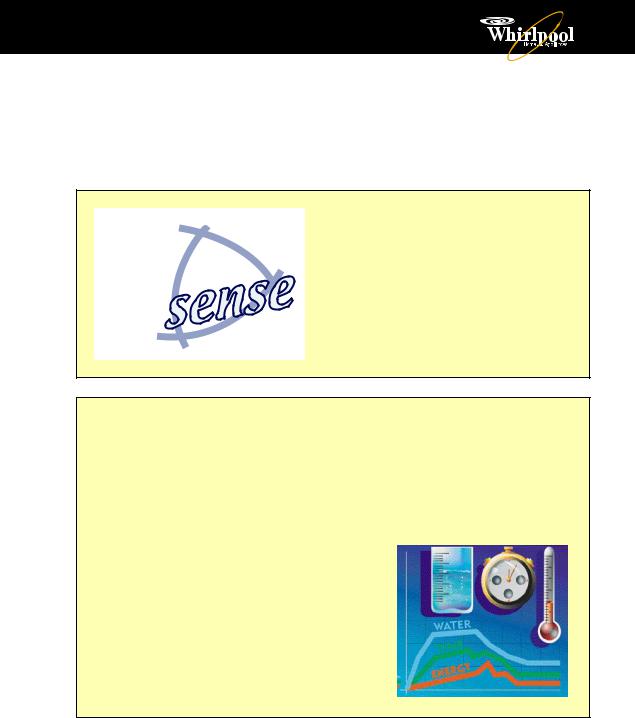
technology6thsense
6 |
6 |
th |
th Sense intelligent technology always |
guarantees perfect results with maximum |
|
|
efficiency whatever the wash load. |
INTELLIGENT
Simply set the fabric selector to the fabric type of the wash load. 6th Sense automatically recognizes the type and size of each load.
PRECISE
6th Sense adapts the programme according to the wash load, and automatically adjusts water intake, energy comsumption and programme time, to produce perfect results every time.
6th Sense machines can use up to 30% less water and take up to 50% less time*.
EFFICIENT
6th Sense produces “best in class” washing performance with “A” Class washing whatever the wash load.
(*) From 5 kg. to 1 kg. on normal 60 degrees cotton cycle.
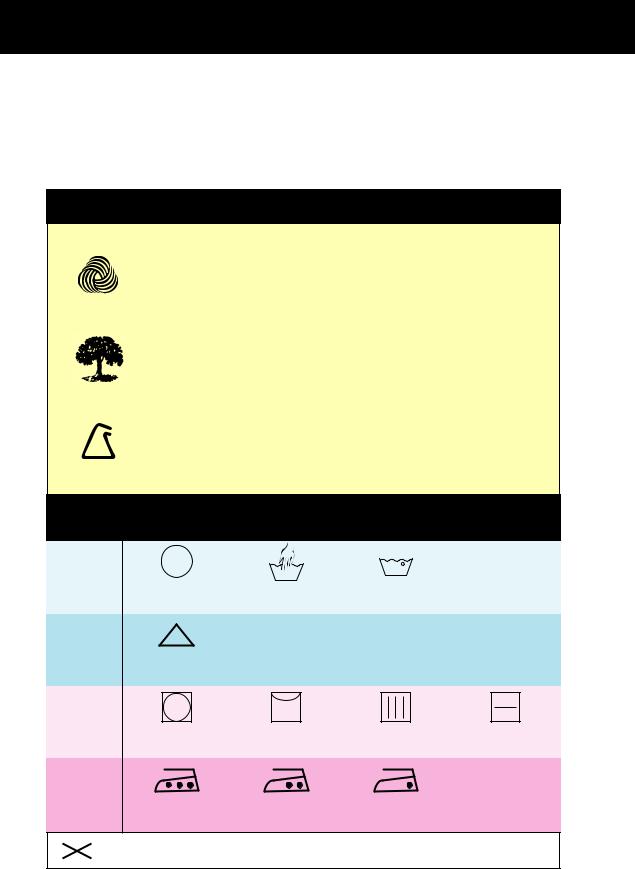
fabricsfabrics
THERE ARE THREE MAIN GROUPS OF FABRICS:
Natural fibres wool and silk or linen, cotton, hemp...
Artificial fibres are obtained from the transformation of a natural product, cellulose, which is spun to produce textile fibres. This group includes acetate, viscose, rayon and modal, which offer the comfort typical of natural fibres.
Synthetic fibres include polyester, polyamide, polyurethane, acrylic fibres and the famous elastan which gives Lycra its stretch.
THE FIRST THING TO DO BEFORE WASHING ANY GARMENT IS TO ....
READ THE LABEL
P |
|
|
The degrees shown |
|
90 |
inside the tube |
|
Washing |
|
|
symbol indicate the |
Dry cleaning |
Handwash |
Machine washable |
maximum wash |
temperature. |
|||
CI |
|
|
|
Bleaching |
|
|
|
May be chlorine |
|
|
|
bleached |
|
|
|
Drying |
|
|
|
Tumble dry |
Hang dry |
Drip dry |
Dry Flat |
Ironing |
|
|
|
Hot |
Warm |
Cool |
|
An  placed against one of these symbols indicates that the treatment is not suitable for this fabric.
placed against one of these symbols indicates that the treatment is not suitable for this fabric.
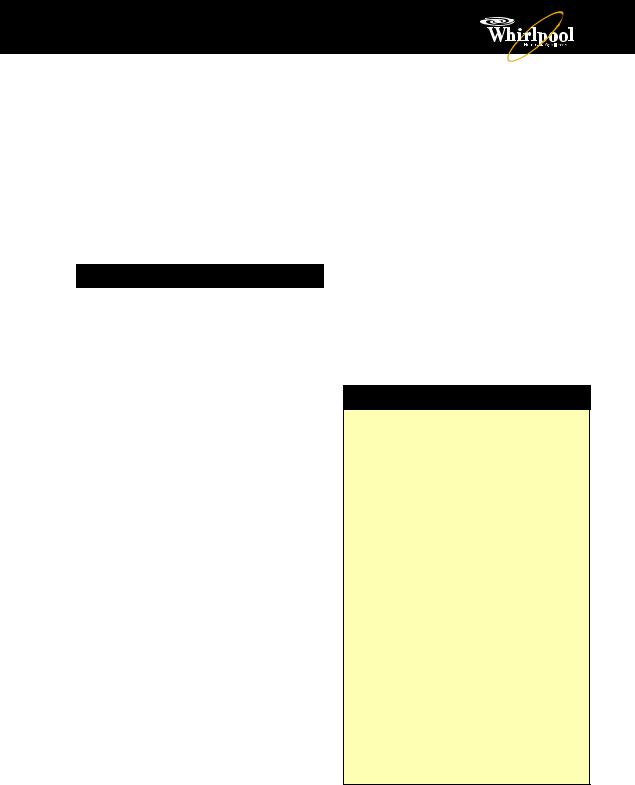
preparing the laundrythe laundry
Behind good wash results lies proper use of the washing machine, a good detergent,
the right choice of wash programme... and a little bit of attention.
BEFORE EVERY WASH.....
Remember to empty the pockets of all garments..
Sort the laundry according to fabric type and colour.
It is generally best to wash any dark or very brightly coloured garments separately, at least for the first wash. In any case, never wash them together with whites.
If a fabric contains a blend of fibres, select the wash programme for the most delicate fibre; and if the label is missing? In this case, since experience may not be enough...treat it gently!
An ideal load includes garments of the same fabric type and degree of soiling, but of varying sizes.
For very delicate garments, deselect the spin cycle before starting the wash.
Ensure the fabric of bras containing wire support is in good condition. Should the wire become detached it could damage your machine.
Tie any straps and belts or, better still, put them into a cotton bag or pillowslip together with other small items (handkerchiefs etc.).
Mend any torn garments which might fray or tear further, and sew on any loose buttons.
Do not machine wash garments with paste jewels or sequins.
For heavily soiled loads, which require more detergent, or terry towelling, select a programme with an extra rinse cycle and remember to add fabric softener to the last rinse.
Remove clothes from the drum as soon as possible: wet fabrics will begin to smell if left inside.
Hand-washing is recommended for garments in cashmere, angora, lambswool and fine silk. Fluffy garments of any kind should always be washed inside out.
WEIGHT OF SELECTED GARMENTS
Garment |
Approx. weight |
|
in grams |
Bath robe |
1200 |
Bath towel |
800 |
Terry hand towel |
150-200 |
Overall |
400-600 |
Blouse |
100 |
Men's shirt |
200 |
Men's t-shirt |
100 |
Men's underpants |
50 |
Handkerchief |
20 |
Sheet |
500-700 |
Pillow case |
200 |
Terry quilt cover |
700-1000 |
Pyjamas |
450 |
Tea towel |
100 |
Napkin |
50-100 |
Tablecloth |
400 |
The weights given refer to cotton or linen when dry.
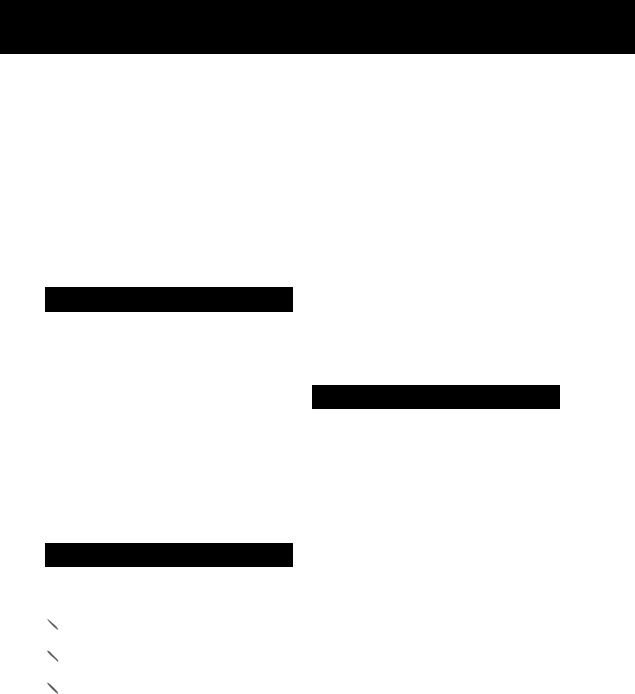
detergentsdetergents and additives
Choose the detergent you find most effective (modern detergents are all designed to give
good wash results while being gentle on colours and fabrics). Make sure to select detergent that is designed for use in washing machines.
HELP IN CHOOSING A DETERGENT
The type of detergent depends on:
 the type of fabric: cottons, synthetics, delicates, wool - (use only specific detergents for wool)
the type of fabric: cottons, synthetics, delicates, wool - (use only specific detergents for wool)
 the colour;
the colour;
 the wash temperature;
the wash temperature;
 the degree and type of soiling.
the degree and type of soiling.
Note:
Whitish residues on dark fabrics are caused by insoluble compounds used in modern phosphatefree powder detergents.
If this occurs, shake and/or brush the affected items or use liquid detergents.
DETERGENT DOSAGES
Follow the instructions on the detergent pack regards to the degree and type of soiling in the load;
full load-follow the detergent manufacturer's instructions;
half load-3/4 the amount used for a full load
minimum load (about 1 kg)-half the amount used for a full load
Generally, more detergent is required when the domestic water supply contains a high concentration of lime (hard water), or for large and heavily soiled loads. Use less detergent in soft water areas or for less soiled items.
Ask for information about water hardness in your area to the water company.
Note:
Too much detergent can result in excess lather, which reduces the effectiveness of the wash. If the appliance senses an excessive amount of foam it may not spin.
Insufficient detergent may result in grey laundry, deposits on the drum, tub and heater.
The detergent drawer has three separate compartments for different wash programmes. See the product information sheet for information about the compartments.
ADDITIVES
Many detergents on the market today already contain additives designed to ensure that whites stay on white and also help remove more stubborn stains. In certain cases, however, normal detergents alone is not sufficient and the addition of the following additives might be necessary:
Perborate: effective at 60° on stains of plant origin and safe on colours and synthetics (Grass, sauces, etc.).
Bleach safe for use on cotton: this is more aggressive than perborate, although gentle bleaches safe even on coloured garments are now available.
Bleaching agents for yellowed silk and wool, are to be used strictly in limited quantities.
Never use bleach, perborate and whiteners together.
Fabric softener: a good fabric softener added to the last rinse cycle smoothes the fibres of fabrics, making ironing easier, and leaves laundry smelling fresh.
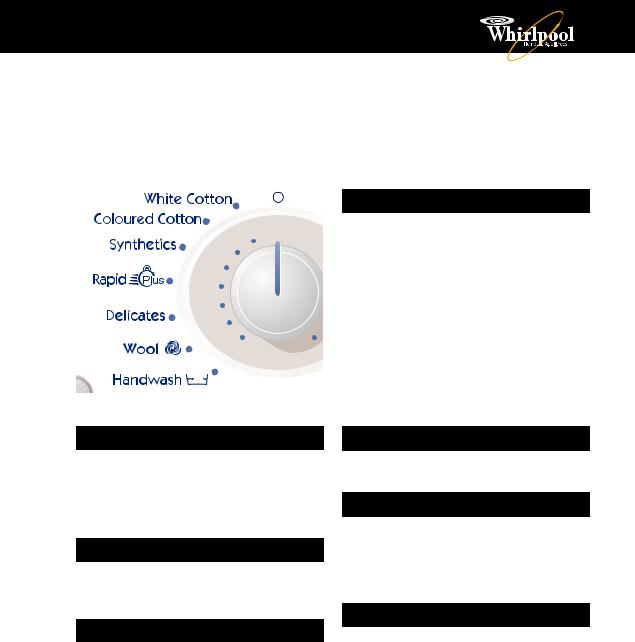
programprogram
WHITE COTTON
Slightly to normally soiled bed linen, table linen and underwear, towels, shirts etc. For heavily soiled loads, the Prewash option can also be selected.
COLOURED COTTON
Slightly to normally soiled bed linen, table linen and underwear, towels, shirts etc.
RAPID PLUS
Ultra-rapid wash programme : washes all fabric types in 30 minutes at 30° C
Suitable for small daily washes (2.5 kg) of lightly soiled garments.
Lightly soiled items in cotton, polyester,
polyamide or cotton blends. |
|
||
You can use the two |
|
|
|
buttons to raise or lower |
20°C |
25 min. |
|
the recommended wash |
30°C |
30 min. |
|
temperature. |
40°C |
35 min. |
|
The wash cycle duration |
|||
60°C |
45 min. |
||
will vary accordingly. |
|||
|
|
||
DELICATES
Delicate curtains, dresses, skirts, shirts, etc.
WOOL
Special programme for washing wool at 20 to 40 °C with maximum 1000 rpm spin cycle. Only machine washable woollens with Pure New Wool label.
SYNTHETICS
Slightly to normally soiled blouses, T-shirts, overalls etc. made of polyester (Diolen, Trevira), polyamide (Perlon, Nylon) or cotton blends.
HANDWASH
Ultra-delicate low temperature (20/30°C) wash programme with gentle spin (maximum 400 rpm). It is suitable for textiles made of linen, silk, wool and viscose marked as “handwashable”.
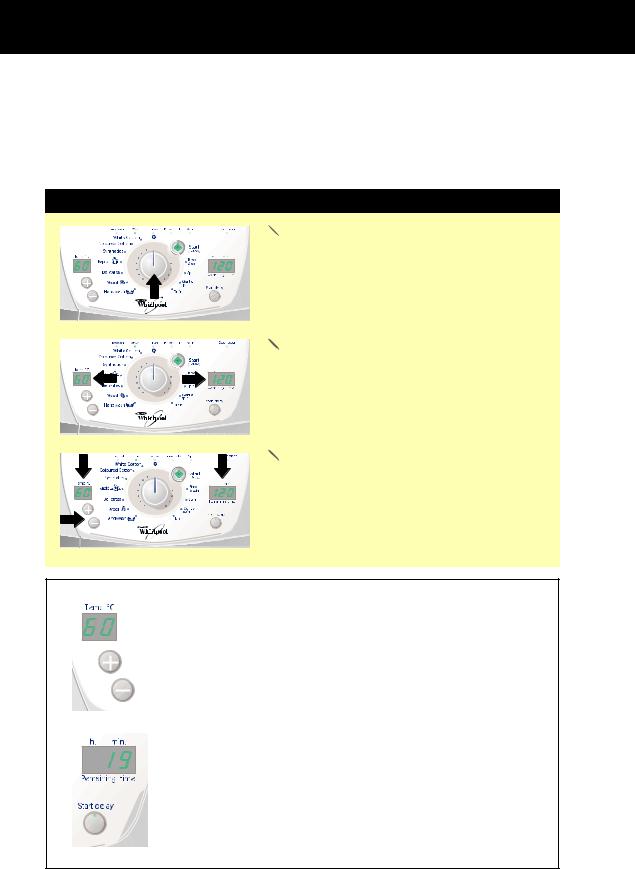
interactivepanelpanel
THE CENTRAL SECTION IS INTERACTIVE
Select the programme suited to your load
The wash temperature, the selected programme and the programme duration are displayed on the panel.
You can use the two buttons to raise or
lower the recommended wash temperature. The display will indicate the programme duration, which depends on the temperature selected.
TEMPERATURE
Wash temperature indicator.
machine to switch on later, for example during off-peak tariff for electricity.
for every hour of delay until the time the pro-
delay" indicator lamp will blink. Press the butdelayed start time.
